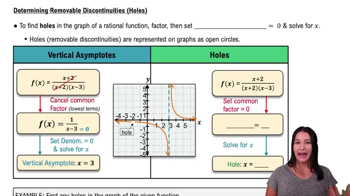Table of contents
- 0. Review of Algebra4h 16m
- 1. Equations & Inequalities3h 18m
- 2. Graphs of Equations43m
- 3. Functions2h 17m
- 4. Polynomial Functions1h 44m
- 5. Rational Functions1h 23m
- 6. Exponential & Logarithmic Functions2h 28m
- 7. Systems of Equations & Matrices4h 6m
- 8. Conic Sections2h 23m
- 9. Sequences, Series, & Induction1h 19m
- 10. Combinatorics & Probability1h 45m
5. Rational Functions
Asymptotes
Problem 43
Textbook Question
Give the equations of any vertical, horizontal, or oblique asymptotes for the graph of each rational function. See Example 4. ƒ(x)=(x^2-2x-3)/(2x^2-x-10)
 Verified step by step guidance
Verified step by step guidance1
<Step 1: Identify the vertical asymptotes by setting the denominator equal to zero and solving for x.>
<Step 2: Factor the denominator 2x^2 - x - 10 to find its roots.>
<Step 3: Determine the horizontal asymptote by comparing the degrees of the numerator and the denominator.>
<Step 4: Since the degrees of the numerator and denominator are equal, the horizontal asymptote is y = (leading coefficient of numerator)/(leading coefficient of denominator).>
<Step 5: Check for oblique asymptotes, which occur if the degree of the numerator is exactly one more than the degree of the denominator. In this case, there are no oblique asymptotes because the degrees are equal.>
Recommended similar problem, with video answer:
 Verified Solution
Verified SolutionThis video solution was recommended by our tutors as helpful for the problem above
Video duration:
8mPlay a video:
Was this helpful?
Key Concepts
Here are the essential concepts you must grasp in order to answer the question correctly.
Rational Functions
A rational function is a function that can be expressed as the ratio of two polynomials. The general form is f(x) = P(x)/Q(x), where P(x) and Q(x) are polynomials. Understanding the degrees of the polynomials in the numerator and denominator is crucial for analyzing the behavior of the function, particularly in relation to asymptotes.
Recommended video:

Intro to Rational Functions
Asymptotes
Asymptotes are lines that the graph of a function approaches but never touches. There are three types: vertical asymptotes occur where the denominator is zero (and the function is undefined), horizontal asymptotes describe the behavior of the function as x approaches infinity, and oblique (or slant) asymptotes occur when the degree of the numerator is one greater than that of the denominator.
Recommended video:

Introduction to Asymptotes
Finding Asymptotes
To find vertical asymptotes, set the denominator equal to zero and solve for x. For horizontal asymptotes, compare the degrees of the numerator and denominator: if they are equal, the asymptote is y = leading coefficient of P / leading coefficient of Q; if the degree of the numerator is less, the asymptote is y = 0. For oblique asymptotes, perform polynomial long division when the numerator's degree is one greater than the denominator's.
Recommended video:

Introduction to Asymptotes

 6:24m
6:24mWatch next
Master Introduction to Asymptotes with a bite sized video explanation from Callie
Start learningRelated Videos
Related Practice








